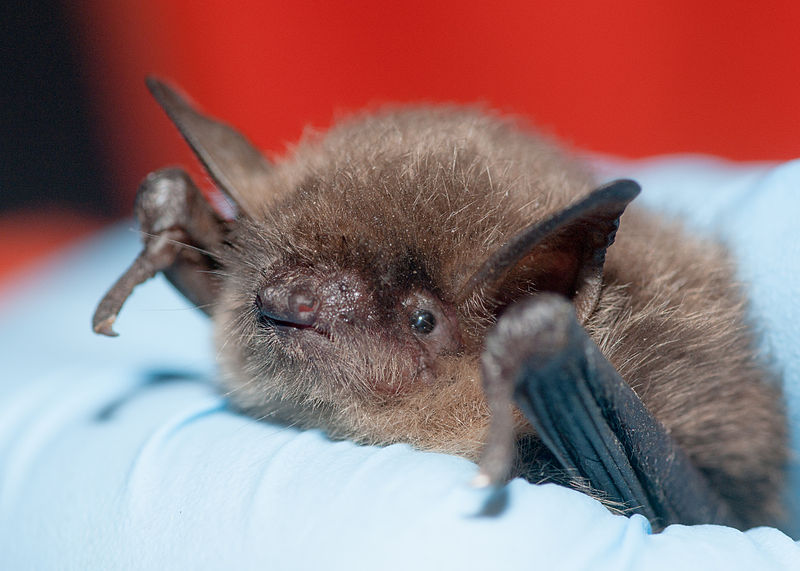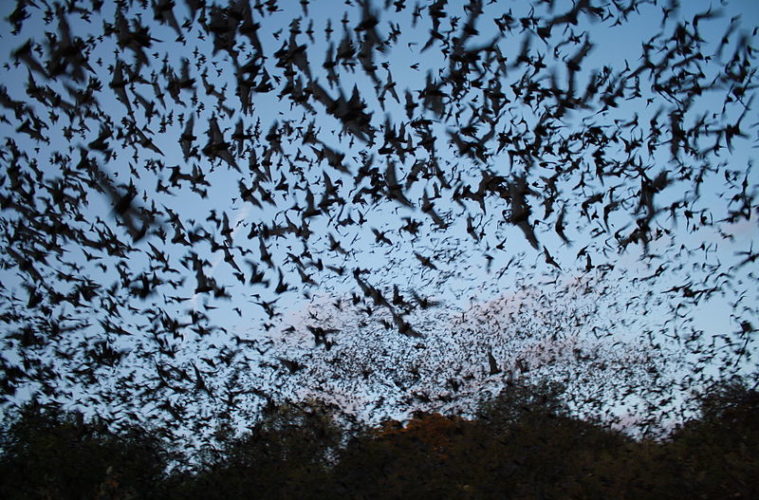It was 7 p.m. on a Friday night, and I was travelling on an isolated little road called Riparian View, which hugs the San Diego Creek just between Michelson Drive and Campus Drive. The sun wasn’t quite setting yet, but the day was winding down, and my destination necessitated darkness. After I pulled into the parking lot of the Sea & Sage Audubon Society, an Orange County chapter of the National Audubon Society, I followed the signs past some buildings wherein other activities were winding down for the day. Finally, I saw my greeters standing around a table with several displays featuring the subject that had brought me here — bats.
Various volunteers adorned in reflective vests excitedly pointed out the display items. These included a collection of children’s books about bats, documents bearing statistics about bats, and several displays of deceased specimens. At 7:15 p.m., the briefing began inside one of the buildings. Stephanie Remington, Orange County’s leading bat biologist and conservationist, presented an informative slideshow to the crowd of around 20 people who had signed up for the evening’s Summer Bat Walks session.
The session, which lasted around an hour, was a basic primer on bats. Throughout the slideshow, which featured photographs of bats from batcon.org (an international organization dedicated to the conservation of bats), Remington identified various characteristics of bat physiology and behavioral tendencies. Among these details were facts about the frequencies and pulse rates that bats use in echolocation (the use of sonar coupled with their enhanced aural attributes) for use in navigation and finding food; details about their sleeping habits; their swimming abilities; different flying styles; etc.
Additionally, she stressed what humans should do in the event that they see a bat — especially insofar as it related to helping them. Foremost among Remington’s advice was that a human should never touch a bat because bats can carry a number of diseases; she said that if a human handles a bat, the animal must be euthanized and tested to determine the likelihood that it could have caused an illness. Furthermore, she urged people whose property contains palm trees that they should not trim those trees in the spring because bats can roost in them, and in the spring baby bats rely on that home for safety until they are able to fly.
 After the presentation, it was time to venture into the field and see some bats. The Sea & Sage Audubon Society is a part of the San Joaquin Marsh and Wildlife Sanctuary, a 300-acre freshwater wetland that is maintained by the Irvine Ranch Water District, whose structures can be seen from the trails of the sanctuary. According to the sanctuary’s website, it is the home for more than 200 bird species, and it functions as a living laboratory for students, teachers and the public. For participants of the Audubon Society’s bat tours, it also provides at least two species of bats for observation: the Mexican free-tailed bat and the Yuma myotis.
After the presentation, it was time to venture into the field and see some bats. The Sea & Sage Audubon Society is a part of the San Joaquin Marsh and Wildlife Sanctuary, a 300-acre freshwater wetland that is maintained by the Irvine Ranch Water District, whose structures can be seen from the trails of the sanctuary. According to the sanctuary’s website, it is the home for more than 200 bird species, and it functions as a living laboratory for students, teachers and the public. For participants of the Audubon Society’s bat tours, it also provides at least two species of bats for observation: the Mexican free-tailed bat and the Yuma myotis.
Before our walk through the sanctuary began, two distinctly tuned sets of bat detectors were distributed to a handful of willing participants — one tuning for each of the two species we were to encounter. Essentially, the instruments register the various pulses and clicks that bats emit; bat echolocation sounds are typically ultrasonic, ranging from around 20 kilohertz (the highest frequency most humans can hear) to 200 kHz. After we had been equipped with our bat detectors, we followed Remington into the marshlands.
A prerequisite to coming on the tour had been that we were all to have worn long-sleeved shirts and pants due to the probability that we’d be bitten by insects. Insect repellent had been recommended as well. As soon as the tour began, I realized that I should have used a repellent. I didn’t actually get bitten by any mosquitos, but I did find myself swatting at insects along the way. In any event, it was now dark out, and a beautiful sea of stars was shining overhead.
As Remington led our band of bat watchers into the field, those of us equipped with the bat detectors held them up in the air in the hopes of intercepting the otherwise inaudible signals. Before long, the devices tuned to the frequencies of the Yuma Myotis started emitting various clicking sounds that were not too dissimilar from those of a Geiger counter. As the tour progressed, and we entered into some choice feeding grounds, adjacent to ponds, we could observe the flitting bat silhouettes that corresponded to the signals we were intercepting. Not too long after, the instruments that were tuned to the frequencies of the Mexican free-tailed bats began making sounds that resembled a sequence of water drops falling into a body of water.
The leisurely walking tour lasted about an hour. It was punctuated with stops at primo areas, where we could both see and hear plenty of bat action. Throughout it all, Remington answered questions, and the volunteers provided additional information about the sanctuary and the Irvine Ranch Water District. At one point, one of the guests, who happened to have a set of night vision goggles passed them around. The goggles provided a bit more visibility, but given how fast the bats move about, they didn’t provide us the ability to see any of the detail of the animals. Still, walking a nature trail at night, in the midst of swarms and straggling bats, with instruments that enabled us to hear their otherwise inaudible echolocation sounds was a unique experience.
Curious souls are encouraged to check out the Summer Bat Walks and learn a bit more about these fascinating creatures of the night. The tour is designed for adults and children 7 or older. The cost is $18 for adults and $10 for children age 7-12. Appointments are necessary, and they can be booked through September 7 at seaandsageaudubon.org/BatInformation/batwalkssummer.htm.
Advertising disclosure: We may receive compensation for some of the links in our stories. Thank you for supporting Irvine Weekly and our advertisers.

